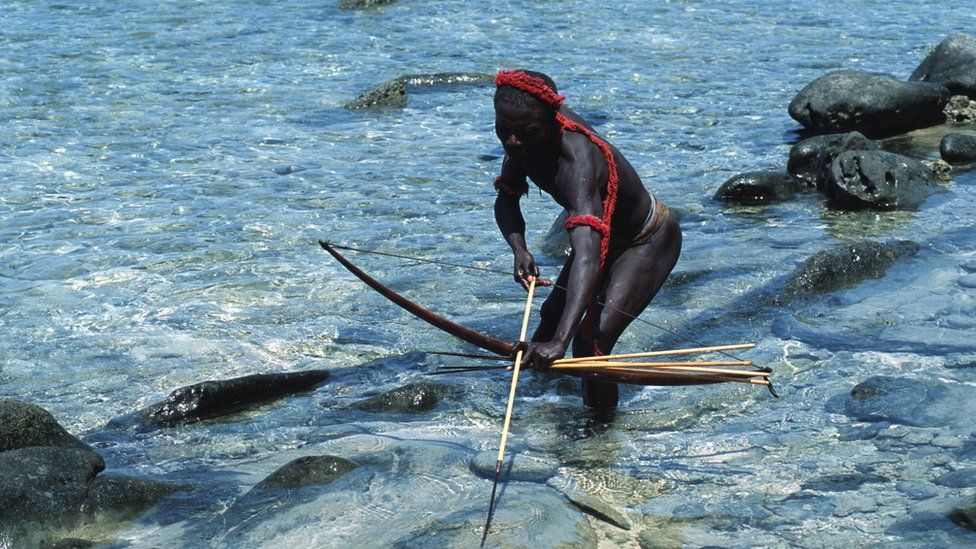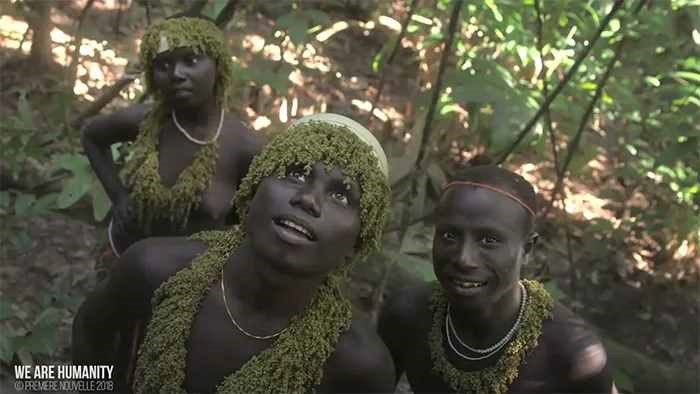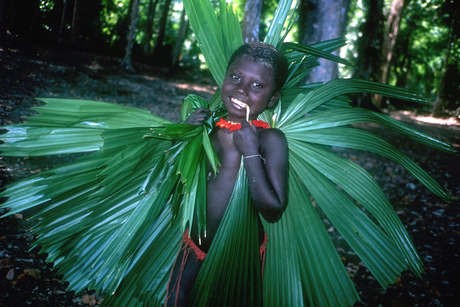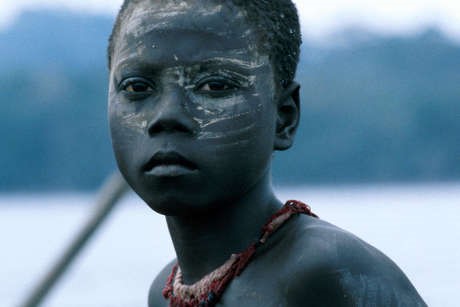The ancient Jarawa tribe lives deep in the jungle in the Andaman Islands, between India and Myanmar. Until 1998, the tribe had been secluded and unaffected by modern civilization for 55 thousand years. Approximately 400 members of the nomadic Jarawa tribe dwell in Chadas, their home, in groups of 40–50 individuals. The Jarawa tribe, like most indigenous peoples who live in peace on their native lands, continues to thrive and grow in numbers. On fringed reefs for reptiles and fish, as well as striped maidens and toothed horses, they hunt pigs, turtles, and fish with bows and arrows. Fruits, wild roots, tubers, and honey are also collected.

The bows are fashioned of Choi wood, which is not found across Jarawa’s region. Jarawa are frequently forced to travel significant distances to collect them on Baratang Island. Jarawa men and women pick wild honey from towering trees in equal numbers. Members of the group sang songs to convey their excitement while collecting honey. The honey collector will chew the juice from the leaves of a plant that repels bees, such as ooyekwalin, and then spray it on the bees with its mouth to keep them away. The Jarawa can chop off the bee nest and place it in a wooden bucket on their backs once the bees have left. After drinking honey, always provide a Jarawa.
Civilization in danger for Jarwas
Thousands of strangers, including tourists, pass through their grounds on the road that runs through them. Divers, local settlers, and foreign hunters come to the Rich Forest Reserve to steal the game the tribe needs to survive, and tourists treat the group like a cartoon at a safari park. They are nevertheless vulnerable to infections against which they have little or no immunity. The Jarawa tribe was hit by measles outbreaks in 1999 and 2006, a disease that has wiped out many tribes around the world after contact with strangers. A pandemic may wipe out an entire tribe. Fishermen, settlers, bus drivers, and others sexually attack the women of Jarawa.

The main threat to the Jarawa’s survival is encroachment on their land, which began in the 1970s with the construction of a highway through their forest. The Andaman Trunk Road (ATR) connects the Andaman Islands to the rest of the world. The Jarawa way of life, which has evolved over the course of humanity’s history, has undergone significant modifications since the indigenous people first came into contact with contemporary people.
JARAWA TRIBE IN ANDMAN NICOBAR AS “HUMAN ZOO“
After learning about civilization, Jarwas has transformed into a “human zoo,” a line of vehicles laden with tourists that runs through the indigenous people’s reserve, where they stroll around half-naked and order meals. Furthermore, taking photographs, filming movies, and contacting members of the tribe are all prohibited by law, yet this does not stop the illegal trips from continuing.

The dishonest actions of visitors who made jaws dance and leaped in exchange for food astonished and shocked the entire world. These individuals have all been photographed and uploaded to the internet. The documentary “We Are Human,” produced by French screenwriter Alexandre Dereim and producer Claire Bellfert, is about Jarawa and how the modern world is relentlessly destroying an old tribe. Jarawa does not want them to be a part of the current civilization, yet their existence is continuously bothering them.

The tribe today has 403 members and is on the verge of extinction in less than ten years unless the Indian government takes immediate action to safeguard them. The Jarawa tribe remained one of the world’s most secluded tribes. They flourished long before the Egyptian pyramids and did not encounter other civilizations until the twentieth century.

“Jarawa” means “enemy,” “enemy,” or “alien” in Bojigngiji, an Andamandan language. This is more than simply a name; it’s a sort of reputation. For generations, legends have spread like wildfire over the world about a murderous tribe of sailors who are also cannibals. After a 22-year journey through Asia, Marco Polo characterised them as “all having heads like a large dog.” The documentary by Derams and Beller, on the other hand, clearly shows the opposite.

The utter lack of communication with the rest of the world has a significant impact. Since the Stone Age, the tribe’s way of life has remained intact. The way they hunt, prepare food, and live their entire lives is influenced by the natural world, which distinguishes their tribe.

There appears to be a significant disconnect between our moral and social roots and their hubris. However, when we discover more about their ideas and perspectives on the world, we realise that there are aspects of human nature that we all share. They adore their children, both men and women, and they experience joy and sorrow. However, as the globe has become more globalised, Garraf’s contact with the outside world has become unavoidable. The Jarawa tribe’s lifestyle has changed dramatically in the past 30 years.
They now dress up, use scissors, and use mirrors. Orchards used to make bees out of beeswax thousands of years ago, but now they use lanterns that modern humans have given them.

Furthermore, the majority of the items were given to the destroyers by poachers who had unlawfully crossed the boundaries of their reserve and killed wild boars, endangering the destroyers’ lives. Aside from the confrontations with fishermen, there is another, maybe more serious threat: in the 1970s, a major road was built on the islands to connect tiny towns with the capital. The road, on the other hand, has been used exclusively for other purposes over time.

Tourists love to visit places where curious and naïve natives go out of the woods, pray, and dance for food, as instructed by unscrupulous police officers, despite government-exempt car restrictions and tight road traffic laws. This behavior was caught on camera and broadcast on the internet, resulting in an international outcry. Many news outlets have referred to the situation as a “human zoo” or “human safari.”

According to experts, if such encounters do not cease, the garave would either face extinction from diseases to which indigenous people are immune or they would be forced to integrate into the modern world. Although assimilation in civilization does not appear to be as horrible as extinction, the chances of this happening are still slim. Jungle lands, which are now protected by the government, are being sold and developed. Without education and financial security, the tribesmen would be employed as cheap labor.
LIFE OF JARAWA TRIBE



Despite the fact that the Supreme Court of India ordered the closure of the Jarawa Reserve’s road in 2002, it remains open, and tourists use it for “human safaris” in Jarawa. Poachers infiltrate the Jarawa forest, stealing the animals that the tribe relies on for sustenance. They also brought alcohol and drugs, as well as sexually assaulting their neighbours’ women. The Jarawa tribe was hit by measles outbreaks in 1999 and 2006, a disease that has wiped out many tribes around the world after contact with strangers.
Why is Cleaning Dirty Sewerage in India a more dangerous job than an Army job?
Because of this work, thousands more people die in India in an entire year than…
Bobby: 50 years of Love, Fashion, and Pop Culture in Bollywood
Only a few films have left such a deep mark on the history of Bollywood…
Dal Baati Churma – Famous Low Cost Traditional Rajasthani Dish, Did you taste it?
Dal (Lentils curry) and Baati is a traditional dish originating from the Indian state of…
What happened to the ancient Sumerians ?
Ancient Sumerians in Mesopotamia, were Mesopotamia’s oldest historical people (modern Iraq). These individuals are credited with creating…
What India think about the LGBT community?
whispers and Staring is a problem for Indians. Indians start staring at anything that makes…
Why do Indians love white-coloured cars?
If you are visiting or are a resident of India, then you will know that…





